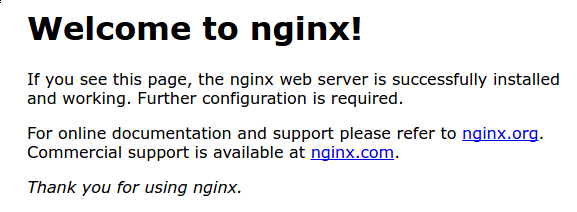Tutorial
How to Install Nginx on Debian 10

Not using Debian 10?Choose a different version or distribution.
Introduction
Nginx is a free and open-source web server used to host websites and applications of all sizes. The software is known for its low impact on memory resources, high scalability, and its modular, event-driven architecture which can offer secure, predictable performance. More than just a web server, Nginx also works as a load balancer, an HTTP cache, and a reverse proxy.
In this guide, you will install Nginx on your Debian 10 server.
Prerequisites
Before you begin this guide, you should have a regular, non-root user with sudo privileges configured on your server. You should also have an active firewall. You can learn how to set this up by following our initial server setup guide for Debian 10.
Step 1 – Installing Nginx
Nginx is available in Debian’s default software repositories, making it possible to install it from conventional package management tools.
First update your local package index to reflect the latest upstream changes:
Then, install the nginx package:
Confirm the installation, entering Y, then press Enter to proceed. apt will then install Nginx and any required dependencies to your server.
Step 2 – Adjusting the Firewall
Before testing Nginx, it’s necessary to modify the firewall settings to allow outside access to the default web ports. Assuming that you followed the instructions in the prerequisites, you should have a UFW firewall configured to restrict access to your server.
During installation, Nginx registers itself with UFW to provide a few application profiles that can be used to enable or disable access to Nginx through the firewall.
List the ufw application profiles by typing:
You should get a listing of the application profiles:
OutputAvailable applications:
...
Nginx Full
Nginx HTTP
Nginx HTTPS
...
As you can see, there are three profiles available for Nginx:
- Nginx Full: This profile opens both port
80(normal, unencrypted web traffic) and port443(TLS/SSL encrypted traffic) - Nginx HTTP: This profile opens only port
80(normal, unencrypted web traffic) - Nginx HTTPS: This profile opens only port
443(TLS/SSL encrypted traffic)
It is recommended that you enable the most restrictive profile that will still allow the traffic you’ve configured. Since you haven’t configured TLS/SSL for your server yet in this guide, you will only need to allow traffic for HTTP on port 80.
You can enable this by typing:
You can verify the change by typing:
What appears are the HTTP traffic allowed in the output:
OutputStatus: active
To Action From
-- ------ ----
OpenSSH ALLOW Anywhere
Nginx HTTP ALLOW Anywhere
OpenSSH (v6) ALLOW Anywhere (v6)
Nginx HTTP (v6) ALLOW Anywhere (v6)
Step 3 – Checking your Web Server
At the end of the installation process, Debian 10 starts Nginx. The web server should already be up and running.
You can check with the systemd init system to make sure the service is running by typing:
Output● nginx.service - A high performance web server and a reverse proxy server
Loaded: loaded (/lib/systemd/system/nginx.service; enabled; vendor preset: enabled)
Active: active (running) since Tue 2022-06-28 18:42:58 UTC; 49s ago
Docs: man:nginx(8)
Main PID: 2729 (nginx)
Tasks: 2 (limit: 1167)
Memory: 7.2M
CGroup: /system.slice/nginx.service
├─2729 nginx: master process /usr/sbin/nginx -g daemon on; master_process on;
└─2730 nginx: worker process
This output reveals that the service has started successfully. However, the best way to test this is to actually request a page from Nginx.
You can access the default Nginx landing page to confirm that the software is running properly by navigating to your server’s IP address. If you do not know your server’s IP address, you can type this at your server’s command prompt:
You will get back a few lines. You can try each in your web browser to see if they work.
When you have your server’s IP address, enter it into your browser’s address bar:
http://your_server_ip
The default Nginx landing page should appear in your web browser:

This page is included with Nginx to show you that the server is running correctly.
Step 4 – Managing the Nginx Process
Now that you have your web server up and running, you can review some basic management commands.
To stop your web server, type:
To start the web server when it is stopped, type:
To stop and then start the service again, type:
If you are making configuration changes, Nginx can often reload without dropping connections. To do this, type:
By default, Nginx is configured to start automatically when the server boots. If this is not what you want, you can disable this behavior by typing:
To re-enable the service to start up at boot, you can type:
Step 5 – Setting Up Server Blocks (Optional)
When using the Nginx web server, server blocks (similar to virtual hosts in Apache) can be used to encapsulate configuration details and host more than one domain on a single server. In the following commands, replace your_domain with your own domain name. To learn more about setting up a domain name with DigitalOcean, see our introduction to DigitalOcean DNS.
Nginx on Debian 10 has one server block enabled by default that is configured to serve documents out of a directory at /var/www/html. While this works well for a single site, it can become unmanageable if you are hosting multiple sites. Instead of modifying /var/www/html, create a directory structure within /var/www for the your_domain website, leaving /var/www/html in place as the default directory to be served if a client request doesn’t match any other sites.
Create the directory for your_domain as follows, using the -p flag to create any necessary parent directories:
Next, assign ownership of the directory with the $USER environment variable, which should reference your current system user:
The permissions of your web root should be correct if you haven’t modified your umask value, but you can make sure by typing:
Next, create a sample index.html page using nano or your preferred text editor:
Inside, add the following sample HTML:
<html>
<head>
<title>Welcome to your_domain</title>
</head>
<body>
<h1>Success! Your Nginx server is successfully configured for <em>your_domain</em>. </h1>
<p>This is a sample page.</p>
</body>
</html>
Save and close the file when you are finished. In nano you can do this by pressing CTRL + X, then Y, and then ENTER.
In order for Nginx to serve this content, you must create a server block with the correct directives that point to your custom web root. Instead of modifying the default configuration file directly, make a new one at /etc/nginx/sites-available/your_domain:
Add the following configuration block, which is similar to the default, but updated for your new directory and domain name:
server {
listen 80;
listen [::]:80;
root /var/www/your_domain/html;
index index.html index.htm index.nginx-debian.html;
server_name your_domain www.your_domain;
location / {
try_files $uri $uri/ =404;
}
}
Notice the updated root configuration to your new directory and the server_name to your domain name. Remember to replace your_domain with your actual domain name.
Next, enable this server block by creating a symbolic link to your custom configuration file inside the sites-enabled directory, which Nginx reads from during startup:
Your server now has two server blocks enabled and configured to respond to requests based on their listen and server_name directives (you can read more about how Nginx processes these directives here):
your_domain: Will respond to requests foryour_domainandwww.your_domain.default: Will respond to any requests on port80that do not match the other two blocks.
To avoid a possible hash bucket memory problem that can arise from adding additional server names to your configuration, it is necessary to adjust a single value in the /etc/nginx/nginx.conf file. Open the file:
Find the server_names_hash_bucket_size directive and remove the # symbol to uncomment the line:
...
http {
...
server_names_hash_bucket_size 64;
...
}
...
Save and close the file when you are finished.
Next, test to make sure that there are no syntax errors in any of your Nginx files:
If there aren’t any problems, the following is the output:
Outputnginx: the configuration file /etc/nginx/nginx.conf syntax is ok
nginx: configuration file /etc/nginx/nginx.conf test is successful
Once your configuration test passes, restart Nginx to enable your changes:
Nginx should now be serving your domain name. You can test this by navigating to http://your_domain. The custom HTML your created in the /var/www/your_domain/html/index.html folder should be rendered here:

Step 6 – Getting Familiar with Important Nginx Files and Directories
Now that you know how to manage the Nginx service itself, you can take some time to familiarize yourself with a few important directories and files.
Content
/var/www/html: The actual web content, which by default only consists of the default Nginx page you saw earlier, is served out of the/var/www/htmldirectory. This can be changed by altering Nginx configuration files.
Server Configuration
/etc/nginx: The Nginx configuration directory. All of the Nginx configuration files reside here./etc/nginx/nginx.conf: The main Nginx configuration file. This can be modified to make changes to the Nginx global configuration./etc/nginx/sites-available/: The directory where per-site server blocks can be stored. Nginx will not use the configuration files found in this directory unless they are linked to thesites-enableddirectory. Typically, all server block configuration is done in this directory, and then enabled by linking to the other directory./etc/nginx/sites-enabled/: The directory where enabled per-site server blocks are stored. Typically, these are created by linking to configuration files found in thesites-availabledirectory./etc/nginx/snippets: This directory contains configuration fragments that can be included elsewhere in the Nginx configuration. Potentially repeatable configuration segments are good candidates for refactoring into snippets.
Server Logs
/var/log/nginx/access.log: Every request to your web server is recorded in this log file unless Nginx is configured to do otherwise./var/log/nginx/error.log: Any Nginx errors will be recorded in this log.
Conclusion
Now that you have your web server installed, you have many options for the type of content you can serve and the technologies you can use to create a richer experience for your users.
Thanks for learning with the DigitalOcean Community. Check out our offerings for compute, storage, networking, and managed databases.
This textbox defaults to using Markdown to format your answer.
You can type !ref in this text area to quickly search our full set of tutorials, documentation & marketplace offerings and insert the link!
I followed the instructions as described but I see “welcome to nginx” page and I don’t see my index.html page. I am missing something.
Hi there,
Make sure that you assign ownership of the directory in which the index.html file is.
sudo chmod -R 755 /var/www/your_domain
sudo chown -R $USER:$USER /var/www/your_domain/html
In my case, $USER:$USER is root. After I change $USER:$USER to
rootthen the issue is gone.Best, Ethan
Make sure to add the proper path to your website in your Nginx config file.
I follow all the instructions, and not redirect.
Hello, for those who you want to add an SSL certification to your server, do not forget to allow Nginx HTTPS rule with ufw.